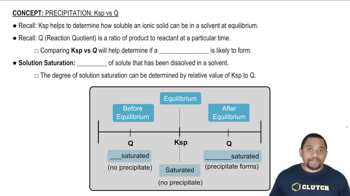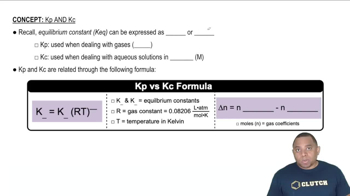The equilibrium constant for the dissociation of molecular iodine, I2(g) ⇌ 2 I(g), at 800 K is Kc = 3.1×10−5. (b) Assuming both forward and reverse reactions are elementary reactions, which reaction has the larger rate constant, the forward or the reverse reaction?
Write the expressions for 𝐾𝑐 for the following reactions. In each case indicate whether the reaction is homogeneous or heterogeneous.
(b) Ti(𝑠) + 2Cl2(𝑔) ⇌ TiCl4(𝑙)
 Verified step by step guidance
Verified step by step guidance
Verified video answer for a similar problem:
Key Concepts
Equilibrium Constant (Kc)

Homogeneous vs. Heterogeneous Reactions

Phase Representation in Kc Expressions

Write the expression for Kc for the following reactions. In each case indicate whether the reaction is homogeneous or heterogeneous.
(a) 3 NO(g) ⇌ N2O(g) + NO2(g)
(b) CH4(g) + 2 H2S(g) ⇌ CS2(g) + 4 H2(g)
(c) Ni(CO)4(g) ⇌ Ni(s) + 4 CO(g)
(d) HF(aq) ⇌ H+(aq) + F-(aq)
(e) 2Ag(s) + Zn2+(aq) ⇌ 2 Ag+(aq) + Zn(s)
(f) H2O(l) ⇌ H+(aq) + OH-(aq)
(g) 2 H2O(l) ⇌ 2 H+(aq) + 2 OH-(aq)
Write the expressions for Kc for the following reactions. In each case indicate whether the reaction is homogeneous or heterogeneous.
(a) 2 O3(g) ⇌ 3 O2(g)
(c) 2 C2H4(g) + 2 H2O(g) ⇌ 2 C2H6(g) + O2(g)
(d) C(s) + 2 H2(g) ⇌ CH4(g)
(e) 4 HCl(aq) + O2(g) ⇌ 2 H2O(l) + 2 Cl2(g)
(f) 2 C8H18(l) + 25 O2(g) ⇌ 16 CO2(g) + 18 H2O(g)
(g) 2 C8H18(l) + 25 O2(g) ⇌ 16 CO2(g) + 18 H2O(l)
Which of the following reactions lies to the right, favoring the formation of products, and which lies to the left, favoring the formation of reactants?
(a) 2 NO(g) + O2(g) ⇌ 2 NO2(g) Kp = 5.0 × 1012
(b) 2 HBr(g) ⇌ H2(g) + Br2(g) Kc = 5.8×10−18
